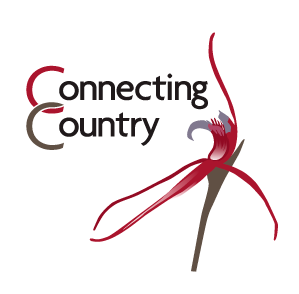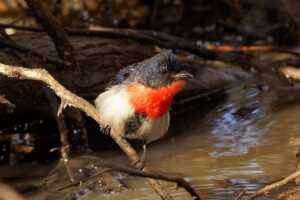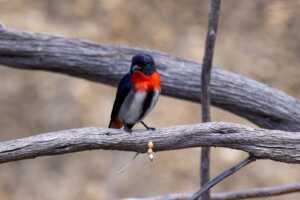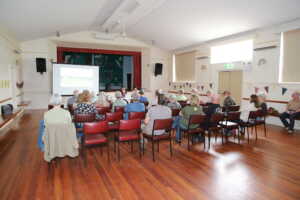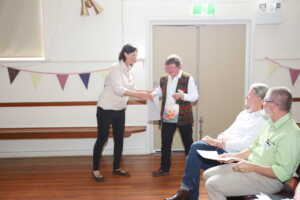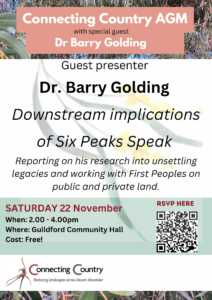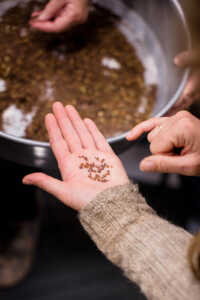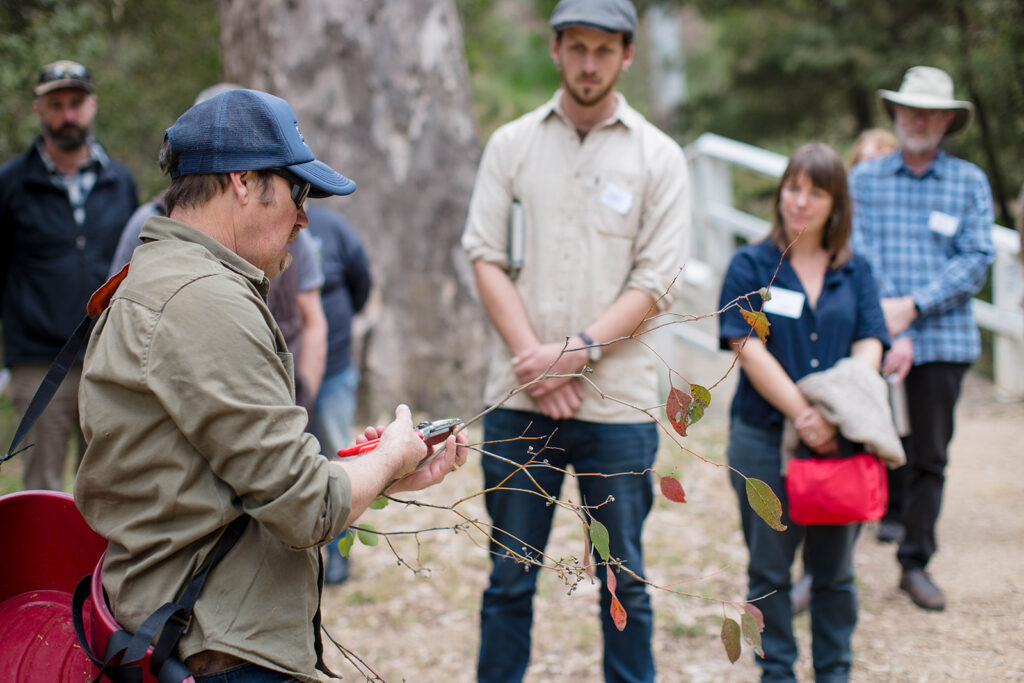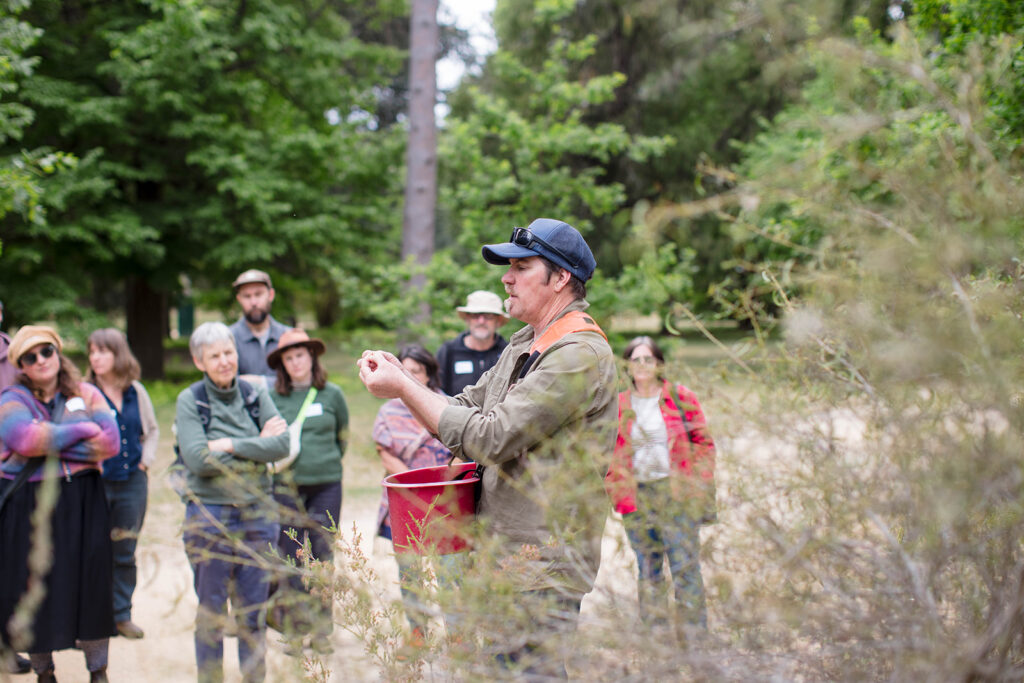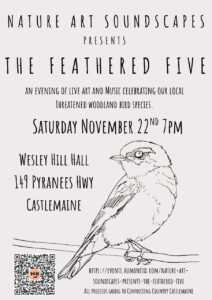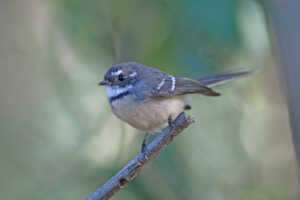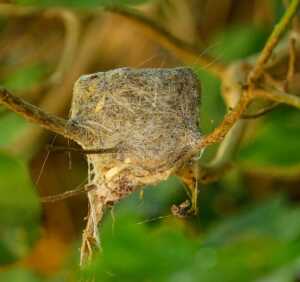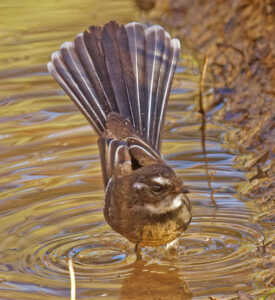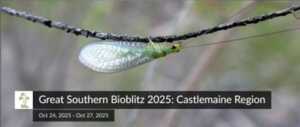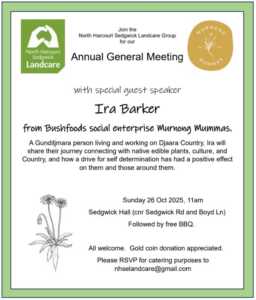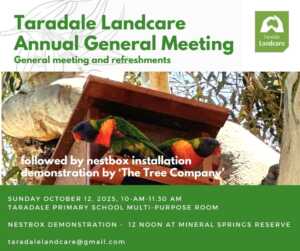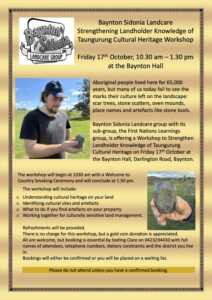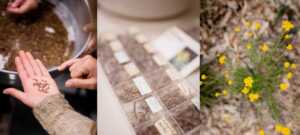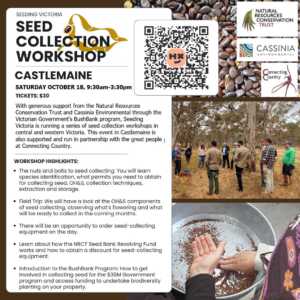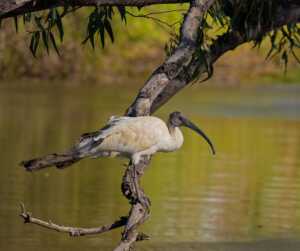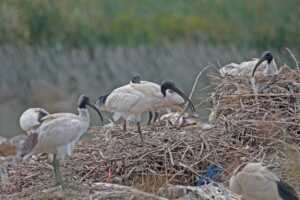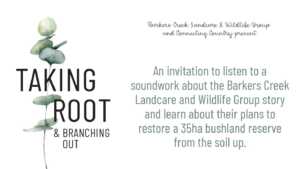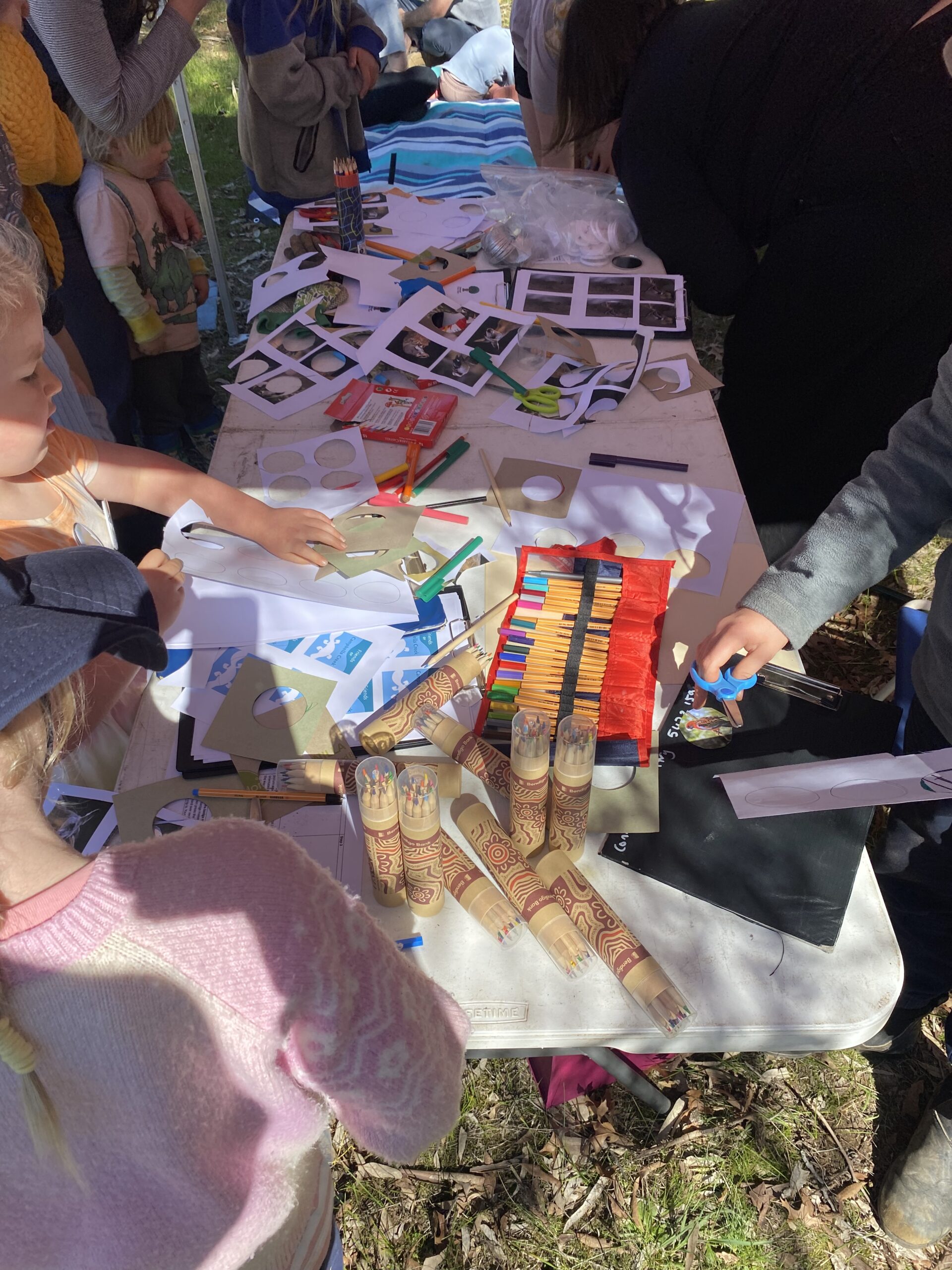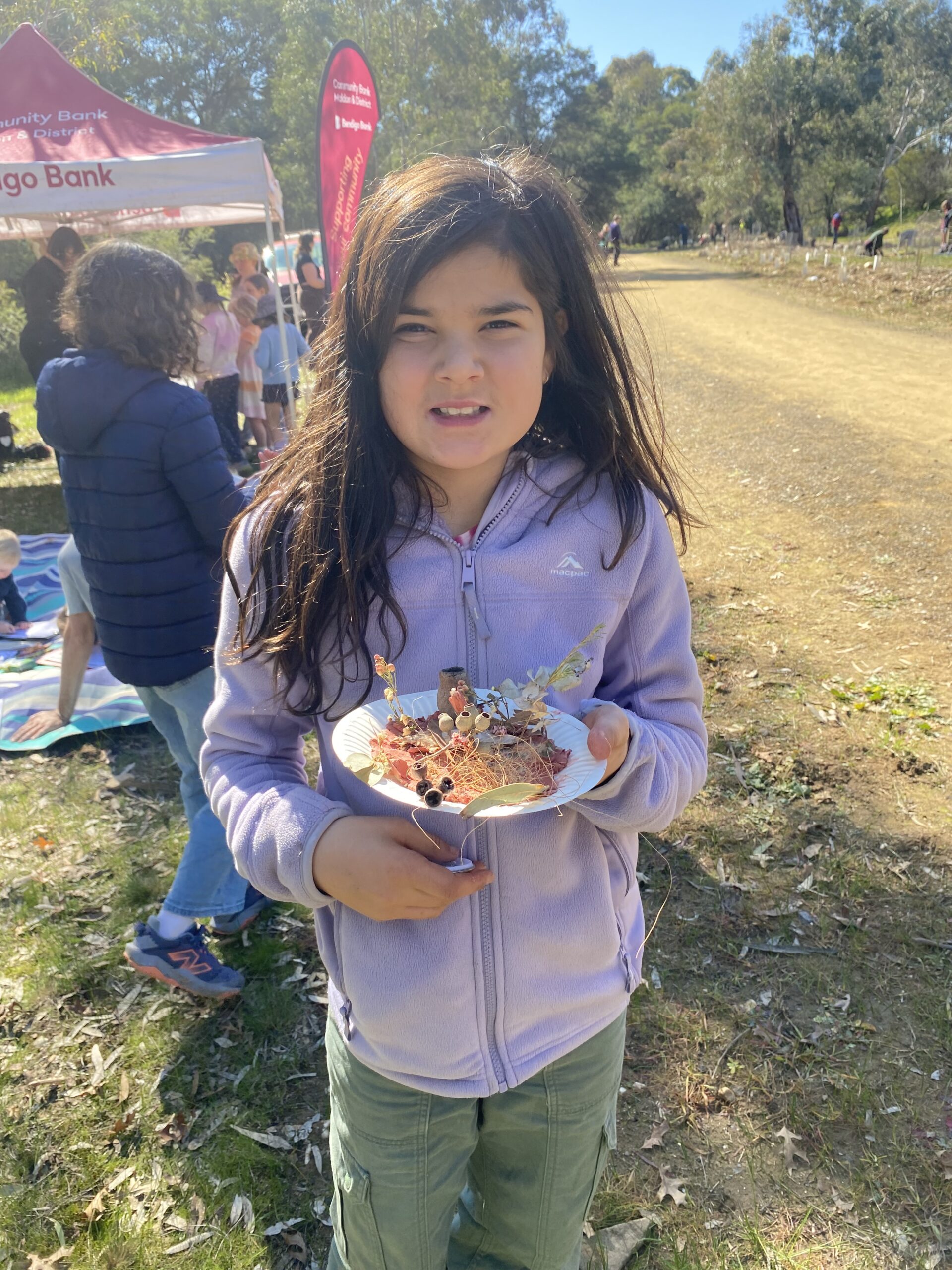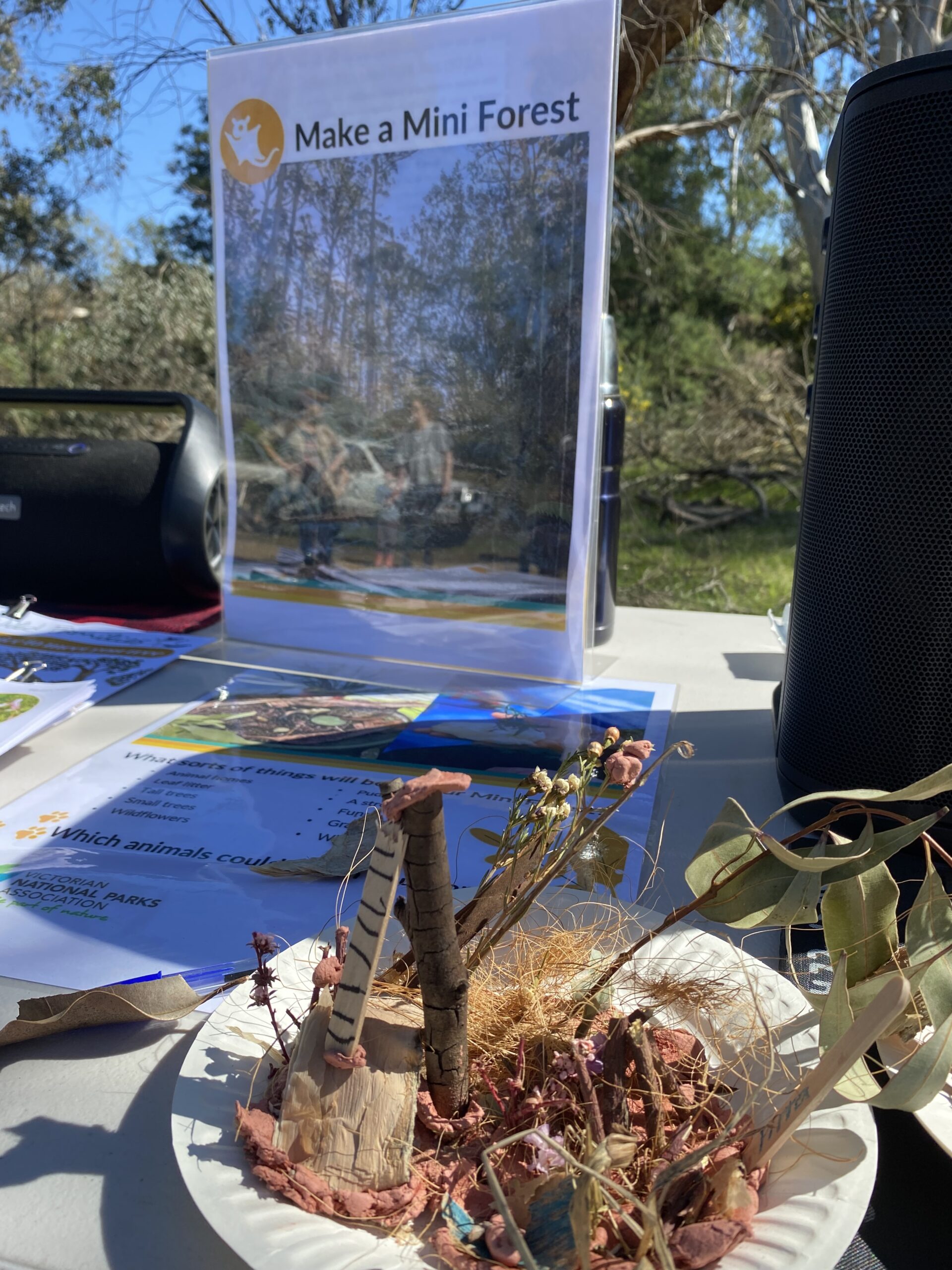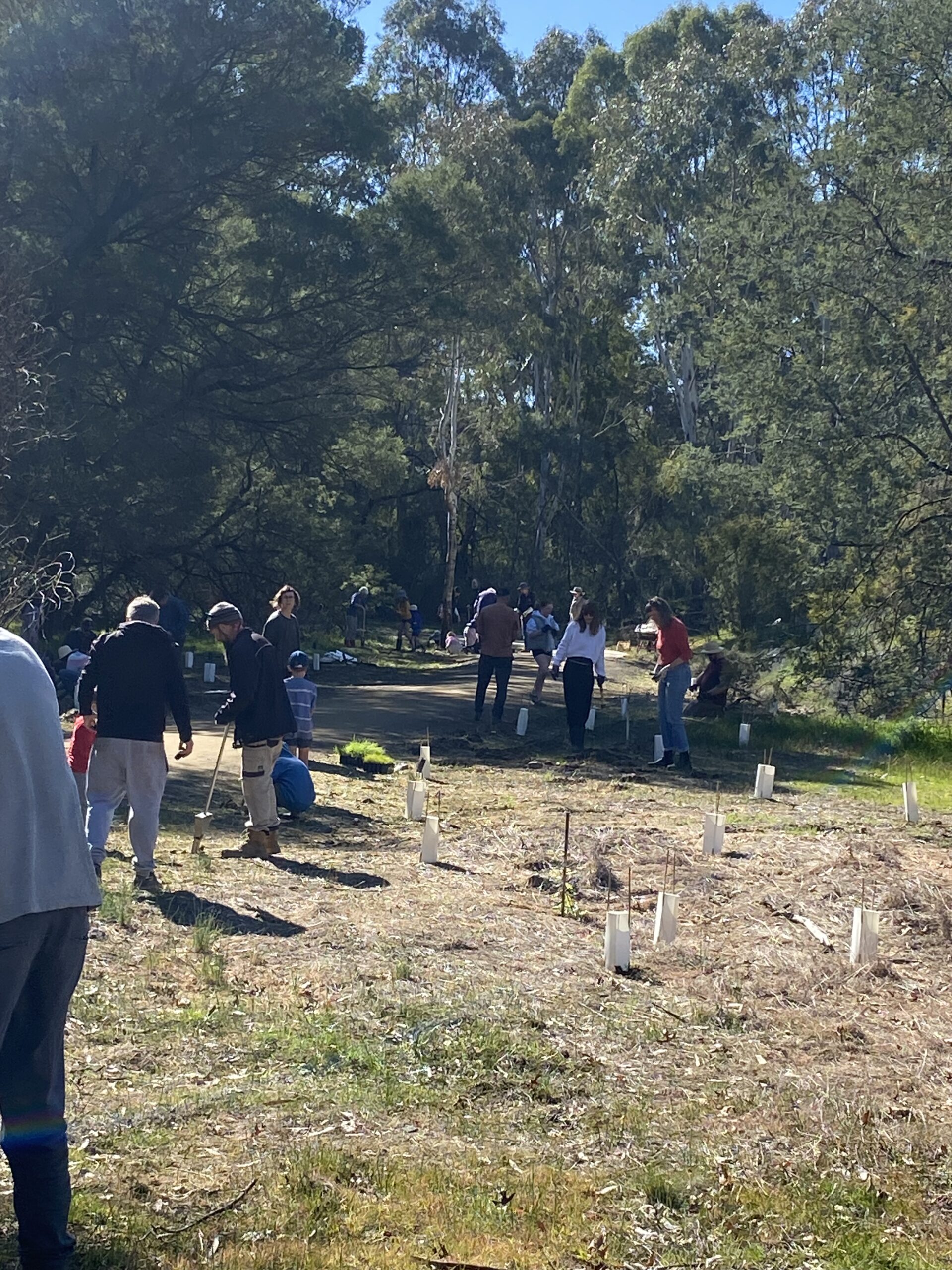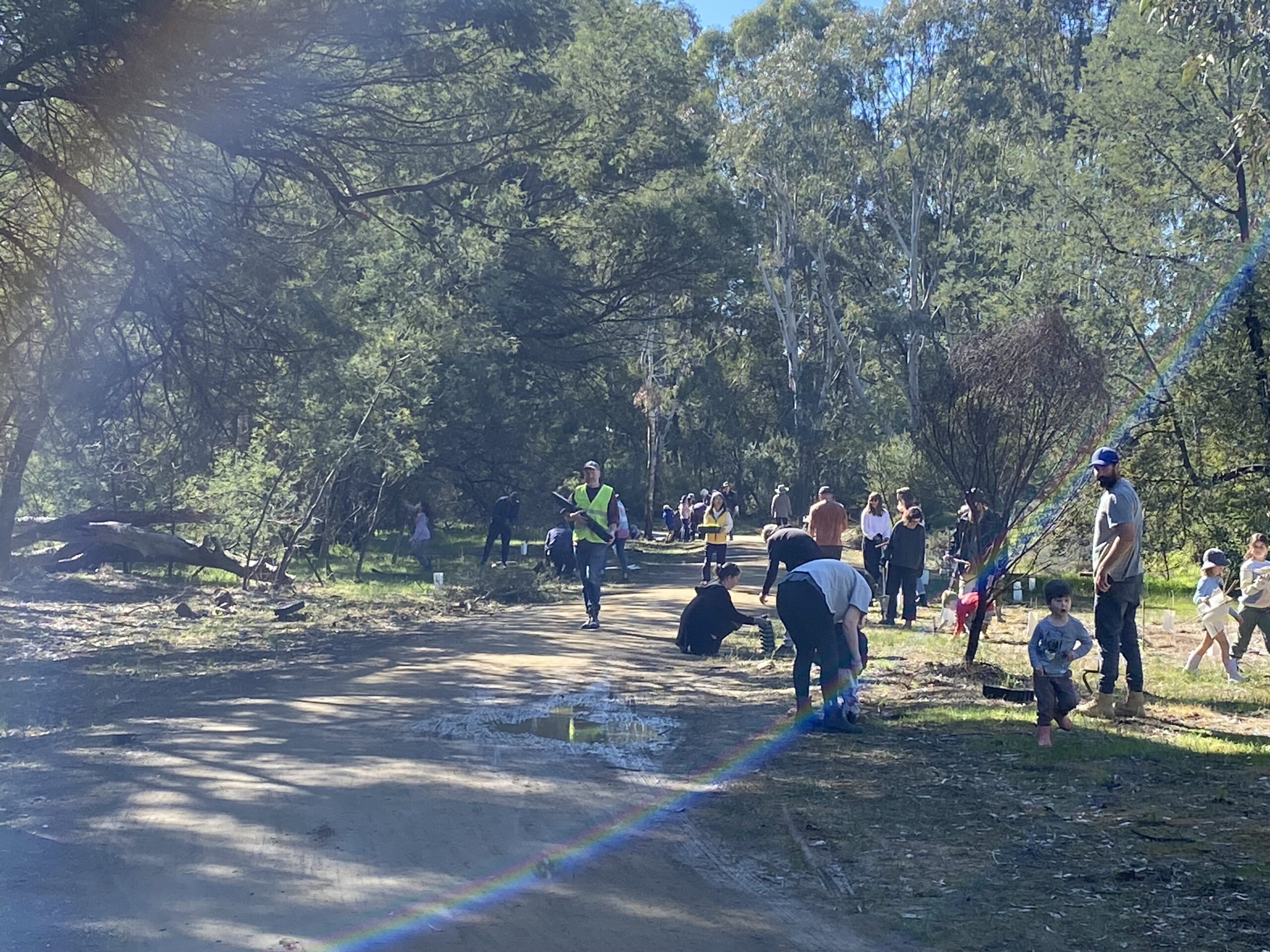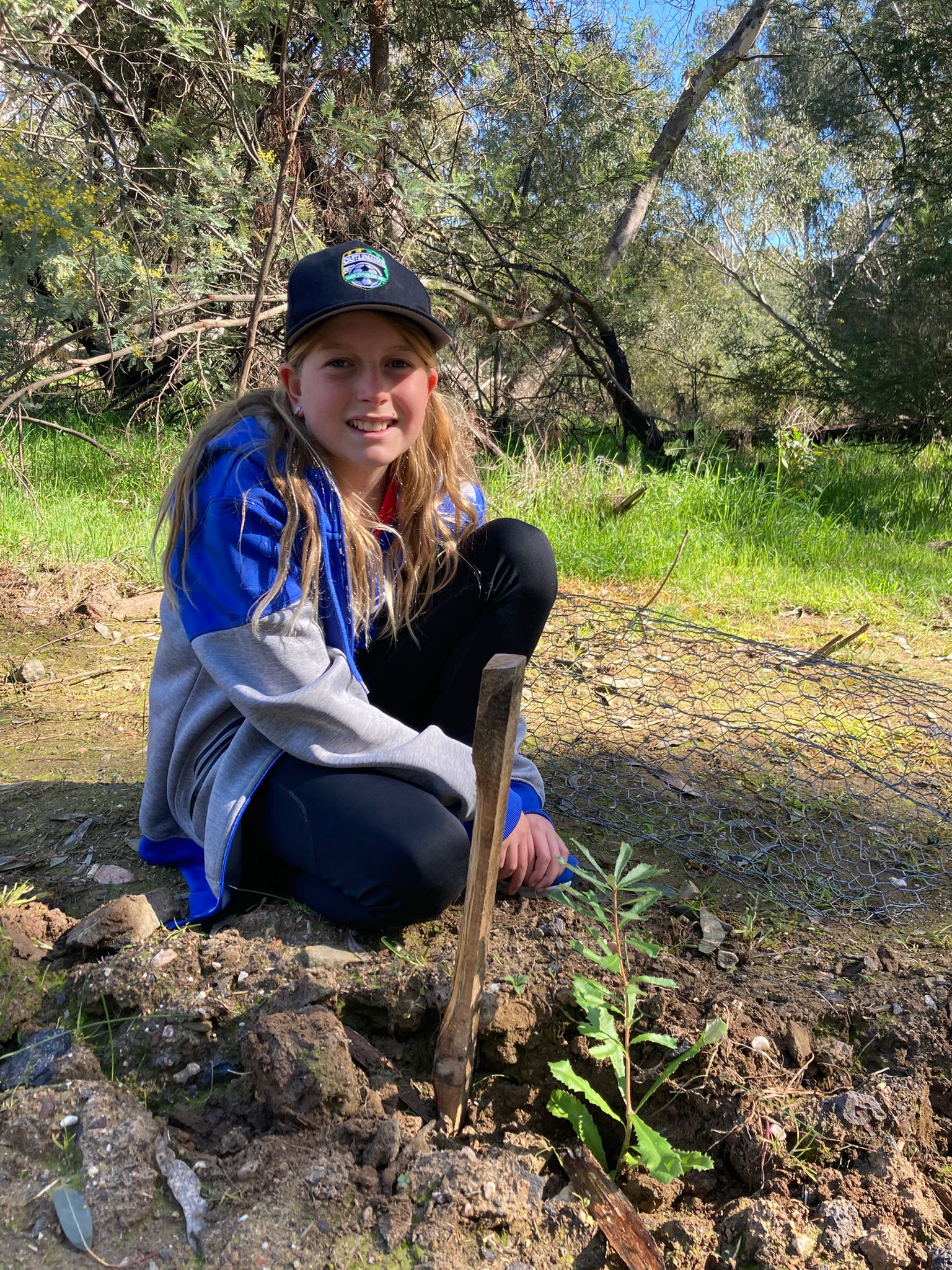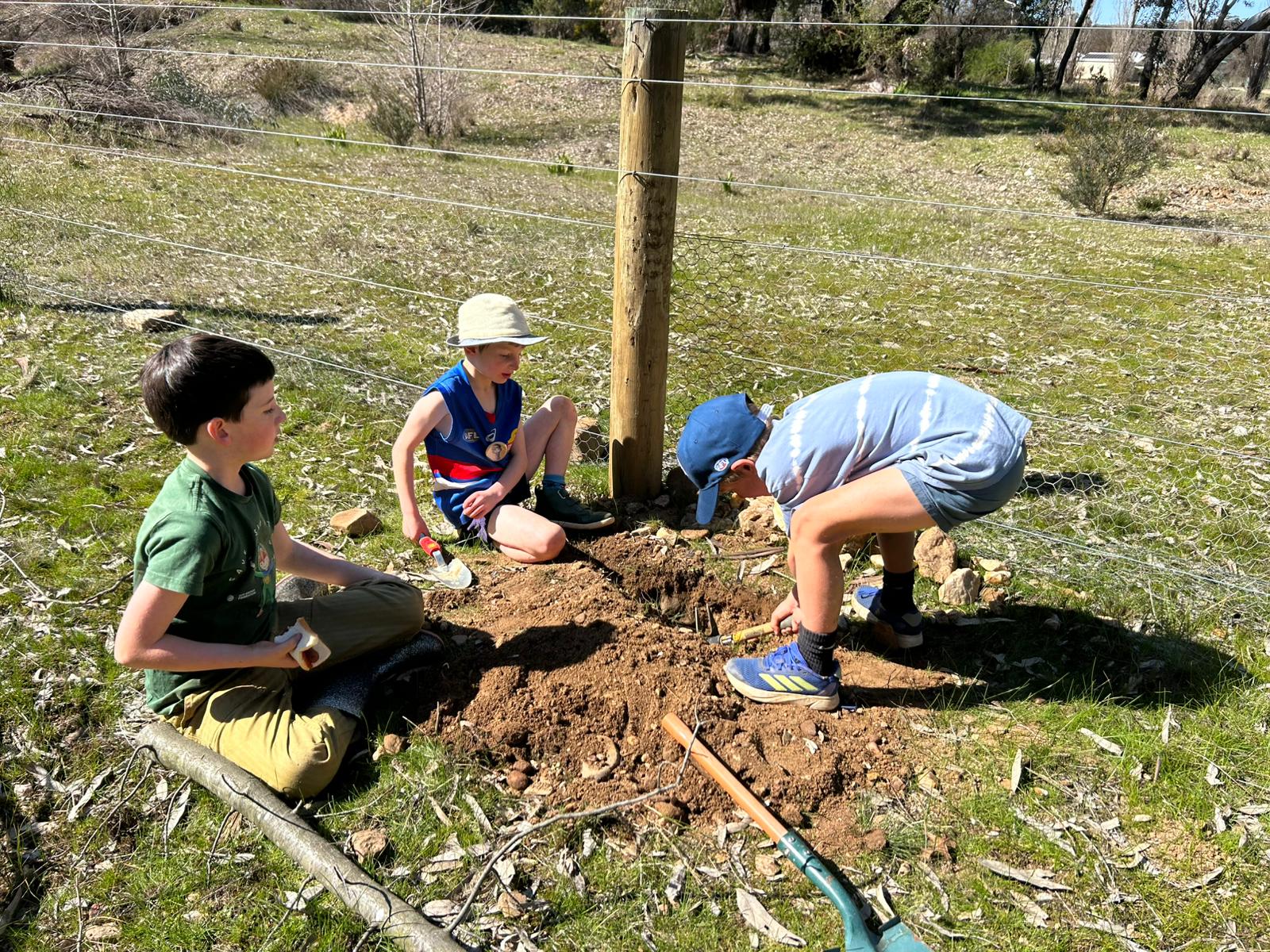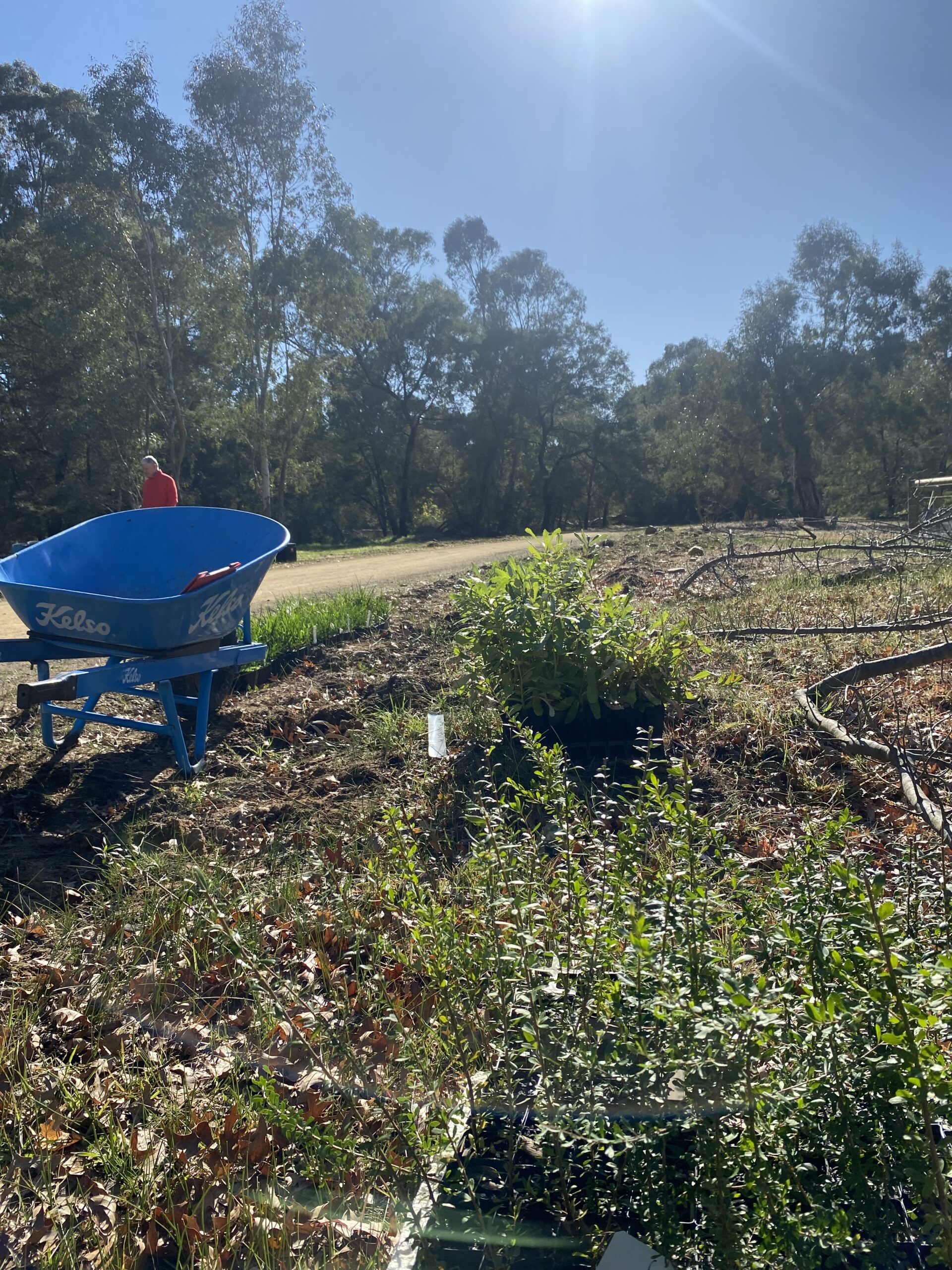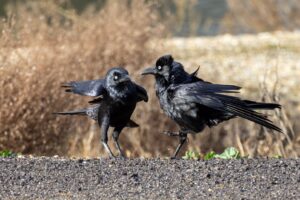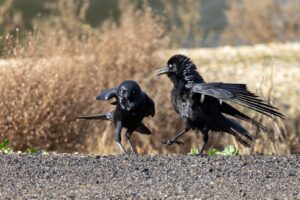Bird of the month: Mistletoe Bird
Posted on 28 November, 2025 by Lori
Written by Damian Kelly and Jane Rusden.
The high squeaky call of the Mistletoe Bird (Dicaeum hirundinaceaum) is what often signals its presence. Then the search is on to find the tiny bird, keeping a look out for the males vibrant fire engine red splash on its chest and under tail coverts. Given its name, it is not surprising that the Mistletoe Bird specialises in mistletoe – a plant that parasitises other plants. Specialisation in one plant may sound a little restricting until you find that there are about 75 different species of mistletoe in Australia. Clearly lots of variety is around.
The close symbiosis, a situation where two species “use” each other and both benefit, between mistletoe and the Mistletoe Bird possibly demonstrates the most highly developed example of this phenomenon amongst Australian birds. This bird is a major vector for the dispersal of the seeds of the plant, spreading them to potential new host trees. Timing of breeding tends to coincide with flowering and fruiting and so assists with cross-pollination and seed germination. The unusual structure of the birds’ digestive system emphasises the degree of specialisation that has evolved. The berries pass through the alimentary canal, but the structure of the digestive system allows for berries to be shunted from the oesophagus to the intestine whilst insect food is diverted to the stomach. Mistletoe seeds are passed about 15-20 minutes after ingestion. It appears only the skin of the berry is removed revealing the very sticky coating, this ensures that a lot of the seeds actually stick to trees as the bird moves about. A completely different take on plant fertilisation. Why the Mistletoe Bird wants to spread seed for the mistletoe plant seems to be a mystery, but perhaps it’s because it harbours so many insects, which are a mainstay food source for the bird?
The distribution of Mistletoe Birds is all over Australia except for some of the drier desert areas, but not Tasmania, and it is resident on some Torres Strait islands. Habitat type does not seem to matter as long as there are mistletoes and with 75 species chances are good that they are present. They also eat a range of insects gathered from foliage.
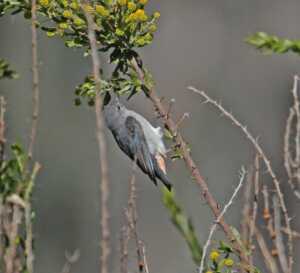
Female Mistletoe Bird, she is grey rather than black and lacks the bright red chest. Photo by Damian Kelly
Nests are precariously suspended from the end of a twig in foliage. It is an enclosed pear shape and is made from lots of soft materials such as wool, woollen threads and such like, and is held together with spiders’ web. A clutch of 2-3 eggs is laid and both parents feed the young – initially only on insects but then also with berries.
A largely sedentary species, they remain in an area all year round although some altitudinal migration has been demonstrated in NSW and Victoria over winter. Banding studies have recorded 98% recovered within less than 10km of the banding site. The oldest bird recorded was over 9 years old which is a fair age for such a small bird.
Mistletoe often gets a bad rap, …except at this time of year when apparently, it’s good for kissing under! But before you think badly of this parasitic group of plants, perhaps think instead of the huge number of species each plant supports, including the beautiful Mistletoe Bird.
Bird of the Month is a partnership between Connecting Country and BirdLife Castlemaine District. Each month we take a close look at one special local bird species. We are blessed to have the brilliant Jane Rusden and Damian Kelly from BirdLife Castlemaine District writing these! We’re excited to join forces to deliver you a different bird each month, seasonally adjusted, and welcome suggestions from the community.
Connecting Country AGM and new committee members
Posted on 25 November, 2025 by Hadley Cole
On Saturday 22 November we held our AGM at the Guildford Community Hall. It was a lovely day to get together and celebrate our achievements for the year. Connecting Country members and supporters enjoyed brief AGM formalities that were followed by a presentation from Dr. Barry Golding and a wonderful afternoon tea provided by the Guildford Store.
Dr. Barry Golding took the opportunity to reflect on his book Six Peaks Speak, published in 2023. Dr. Golding spoke of the great amount of evidence that is recorded in Central Victoria demonstrating Dja Dja Wurrung occupation of this Country for millenia, and the importance of protecting artefacts and culture that still exist in the landscape. The ‘Six Peaks’ refers to Mounts Kooroocheang/Gurutjanga, Beckworth/Nyaninuk, Greenock/unknown, Tarrengower/Dharrang Gauwa, Alexander/Liyanganuk, and Franklin/Lalkambuk. In his book Golding shares the knowledge and history each mountain holds within their geology and writes of the importance of recognising and understanding the unsettling colonial history in the region.
This years’ AGM saw a changing of the guards as the committee farewelled long term committee member and one of the early advocates for Connecting Country Marie Jones. Outgoing president Brendan Sydes thanked and congratulated Marie for hear many years (almost two decades) of dedication to our grass roots community organisation. He noted her thorough understanding of how small, community organisations work and her diligence in knowing what needs to get done, and getting in there and getting it done. Marie’s natural approach to working with community and bringing people into the fold has been a foundation to the success of Connecting Country from the early beginnings. “You should be very proud of what you have achieved here” Brendan shared.
The entire Connecting Country community will miss Marie dearly. She has been a stalwart in the organisation since inception and has always made herself available to staff and volunteers alike.
We also saw the changing of committee roles with Brendan Sydes stepping down as president after 12 years and handing the reigns over to Stephen Oxley who has been sitting on the committee as a general member for the last 3 years. Cate Sinclair has stepped into the role of Secretary taking over from Marie after sitting on the committee as a general member for the previous 12 months. As it stands the new committee is;
President: Stephen Oxley
Vice President: Brendan Sydes
Secretary: Cate Sinclair
Treasurer: Max Kay
General members: Christine Brooke, Darren Tinker, Deirdre Slattery, Ben Welsh
We would would like to acknowledge new members Darren and Ben and returning member Deirdre and thank them for their willingness and commitment to Connecting Country. We look forward to achieving many more great outcomes for the environment together!
Connecting Country’s 2025 AGM was made possible due to the generous donation of community donors.
Connecting Country AGM with Dr Barry Golding
Posted on 13 November, 2025 by Hadley Cole
Join us for the Connecting Country 2025 AGM with special guest presenter Dr. Barry Golding on Saturday 22 November at the Guildford Community Hall.
Following brief AGM formalities, Dr. Barry Golding will give a presentation on the downstream implications of his book Six Peaks Speak, focussing on some of the broader implications and outcomes of his research for dealing with unsettling legacies and working with First Peoples on public and private land.
Dr Barry Golding AM is an Honorary Professor with Federation University in Ballarat. He self-describes as a ground-up, community-oriented, polymathic, place-based researcher and story teller. His degrees span four disciplines: geology, arts, environmental sciences and education. Barry has researched and published internationally about vocational, adult, community, First Nations and informal learning.
In 2023 Barry undertook a State Library Victoria Creative Fellowship, researching and writing a book, Six Peaks Speak: Unsettling legacies in southern Dja Dja Wurrung Country, published in 2024 with local geologist, Clive Willman and in close discussion with Dja Dja Wurrung people.His presentation on Saturday 22 November will focus on his learnings since the release of in 2024. It’s sure to be a fascinating discussion!
Presentations will be followed by a delicious afternoon tea.
When: Saturday 22 November 2025, 2.00 – 4.00pm
Where: Guildford Community Hall, 32 Fryers Street Guildford VIC
Cost: Free!
Please book for catering purposes – click here
Newstead Landcare AGM with guest presenter Tanya Loos
Posted on 7 November, 2025 by Hadley Cole
Our friends at Newstead Landcare are holding their AGM on Tuesday 11 November with guest presenter Tanya Loos!
Where: Newstead Community Centre, 9 Lyons St. Newstead VIC
When: Tuesday 11 November 2025
Cost: Gold coin donation appreciated
Tanya Loos will be talking about the joys and challenges of living with wildlife. A central Victorian local, Tanya is a field naturalist, author, and science communicator. Of Tanya’s latest book, Living with Wildlife, Dr Danielle Clode (award-winning author), said, “In a world of changing climates and decreasing natural habitat we all need to adapt to survive. Living with Wildlife provides a practical, accessible and engaging guide to sharing our spaces with the wildlife our homes have displaced. Filled with sensible, achievable tips for a safe and peaceful co-existence with a wide range of species, this book is an essential resource for all nature lovers who want to share their world with Australia’s remarkable wildlife.”
In Central Victoria we are lucky to be surrounded by native habitats and wildlife. We can either have a negative or positive impact on the wildlife that live in our backyards or make their way into our homes. Tanya gives real-world examples and practical tips to help manage issues such as birds hitting the window through fun and engaging stories. If you haven’t heard Tanya speak before (or even if you have!), this is one not to miss.
All welcome!
Supper will follow the talk, gold coin donations appreciated.
If you are interested in nominating for the committee, please email Secretary Patrick: patrickkavanagh@bigpond.com
Connecting Country AGM 2025 with special guest speaker, Professor Barry Golding
Posted on 6 November, 2025 by Lori
Please join us for our AGM with special guest speaker Professor Barry Golding – author of Six Peaks Speak, on Saturday 22 November 2025 from 2.00pm to 4.00pm
Dr Barry Golding AM is an Honorary Professor with Federation University in Ballarat. He self-describes as a ground-up, community-oriented, polymathic, place-based researcher and story teller. His degrees span four disciplines: geology, arts, environmental sciences and education. Barry has researched and published internationally about vocational, adult, community, First Nations and informal learning. In 2023 Barry undertook a State Library Victoria Creative Fellowship, researching and writing a book, Six Peaks Speak: Unsettling legacies in southern Dja Dja Wurrung Country, published in 2024 with local geologist, Clive Willman and in close discussion with Dja Dja Wurrung people.
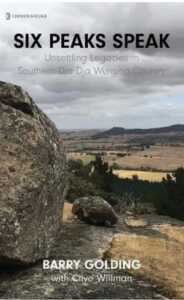 Six Peaks Speak tells the unique stories and continuing legacies of the ancient mountains in the Central Victorian region from a multidisciplinary perspective. The book bears witness to ‘unsettling’ changes over the past 200 years, as viewed from the perspective of the peaks (including Dharrang Gauwa – Mount Tarrengower and Liyanganyuk banyul – Mount Alexander) that stand sentinel over an ancient volcanic landscape and its immense natural and cultural significance.
Six Peaks Speak tells the unique stories and continuing legacies of the ancient mountains in the Central Victorian region from a multidisciplinary perspective. The book bears witness to ‘unsettling’ changes over the past 200 years, as viewed from the perspective of the peaks (including Dharrang Gauwa – Mount Tarrengower and Liyanganyuk banyul – Mount Alexander) that stand sentinel over an ancient volcanic landscape and its immense natural and cultural significance.
When: Saturday 22 November 2025 at 2.00pm – 4.00pm
Where: Guildford Community Hall, 30 Fryers St Guildford VIC
Cost: Free!
Delicious afternoon tea provided.
Everyone is welcome! For catering and logistical purposes, please register your attendance – click here
Dr. Barry Golding will present after brief AGM formalities.
AGM formalities
The following Connecting Country AGM 2025 documents are available to download:
Please note only current Connecting Country members can vote in the AGM. To become a member – click here
For more information please email info@connectingcountry.org.au or phone 0493 362 394
Nominate for the Committee of Management
Want to be more involved with Connecting Country? Why not consider becoming a committee member. We are actively looking for new committee members to broaden the skills of our Committee. The positions require 2 hours per month to attend committee meeting plus small amounts of reading or work time as required to keep the organisation rolling. If this sounds like you, please complete a nomination form or contact our office to discuss via info@connectingcountry.org.au.
The 2025 AGM is kindly sponsored by local community donors.
If you would like to donate to Connecting Country’s cause in promoting local conservation action and restoring landscapes, head over to our Give Now donation page – click here
Seeding Our Future Project 2024/25
Posted on 30 October, 2025 by Hadley Cole
Back in November 2024, Connecting Country kicked of the Seeding Our Future project funded through the 2024 Victorian Landcare Grants. The scope of the project wass to help protect and conserve locally rare and threatened plant species through a series of educational workshops that build knowledge and skills within our local community.
Indigenous seed security is a concern for many in the natural resource management sector. With increased fragmentation of landscapes and the changes in weather patterns and climate due to global heating, the future of many plant species is under threat. Grand scale restoration works are needed and programs such as the Victoria Governments Bushbank program require huge quantities of seed to meet restoration targets. Seeding Victoria are working with project partners Cassinia Environmental and the Natural Resources Conservation Trust to raise awareness of seed security and provide training and resources to aspiring seed collectors to increase seed supply and availability.
The Seeding Our Future project compliments the work Seeding Victoria and partners are undertaking to raise the importance of seed conservation. Considering this, for the first workshop we hosted in November 2024 we partnered with Seeding Victoria in a Seed Collection Workshop at the Botanical Gardens in Castlemaine. The workshop was sold out with keen participants coming along from as far away as Reservoir!
Dan Frost from Seeding Victoria talked us through the basics of seed collection including the equipment needed, permits required and the various collection processes for different indigenous plant species. After a morning in the classroom, we went for a walk through the Botanical gardens and up to the bush land reserve behind the gardens to explore which local plants are currently flowering, seeding or close to seeding and how you might approach collecting and storing their seed.
Dan talked us through the adapted seed collection techniques for various plant families including some grasses, daisies, acacias, eucalypts, bottle brushes, and cone producing plants.
November until late summer is some of the best times for seed collection in the local area, so for aspiring seed collectors this was the perfect time to build a knowledge base and learn about the permits required before getting out there to collect!
Participants reported that they thoroughly enjoyed the workshop. A big thank you to Dan and Robert from Seeding Victoria for sharing their deep knowledge of local seed. We hope to see the future of seed collecting secured and many of our local plant species conserved and protected.
Below photo shows Dan Frost from Seeding Victoria presenting on various collection techniques to a very engaged audience. All photos in this post by Carmen Bunting.
Nature Art Soundscapes presents The Feathered Five!
Posted on 30 October, 2025 by Lori
A truly special, immersive art and music event, celebrating some of our treasured local woodland birds.
Nature Art Soundscapes are musicians Hilary Blackshaw (violin, guitar and vocals), Joel Bloom (lap steel guitar), Clara Schutz (cello) and artist Jane Rusden. The quartet celebrates local woodland wildlife through weaving beautiful live art making with evocative musical soundscapes.
Audiences are invited to immerse themselves in the magic and wonder of local nature, through gentle relaxation (BYO cushions, blankets and/or PJs – we seriously don’t mind!), or you are welcome to bring your own art supplies and draw along with Jane.
When: Saturday 22 November 7-9pm
Where: Wesley Hill Hall, 149 Pyranees Highway, Castlemaine
Tickets: Adults $20, children (under 18) free. Book here or available at the door.
All proceeds generated from this performance will be donated to Connecting Country Castlemaine to assist their woodland bird monitoring project.
Bird of the Month: Grey Fantail
Posted on 20 October, 2025 by Lori
Words by Damian Kelly and Jane Rusden. Photos by Damian Kelly
Always a delight to watch, the Grey Fantail (Rhipidura fuliginosa) swishes its tail around directing insects into easier catching distance. And then there’s their tinkling call, often heard before the bird is seen. Luckily for us bird watchers, Grey Fantails can be very curious, which means they come much closer to us than many other species. They do have rather a disapproving look on their tiny faces, characterised by their drawn down white eyebrows.
A confiding and widespread species, the Grey Fantail can be found all along the wetter eastern and western areas of Australia and occasionally spreading into drier areas inland. Tasmania, New Zealand and other islands also have populations of this species.
Urban gardens are also utilised and here in Castlemaine, in our garden near the centre of town, a pair of Grey Fantails has successfully fledged young for the last two years. The nest is concealed in dense vegetation right next to a garden path, but human traffic does not seem to concern them. Whenever I walk past, a beady eye is watching me, but the bird never leaves the nest. Two young were raised each time which is quite a feat given the tiny size of the nest. Built from small twigs, grass and hairs and held together with spiders’ webs, the nest is a beautiful construction. The nest from two years ago was simply refurbished with more web prior to the second season of breeding (see photo).
Although not fully understood, the movements of Grey Fantails are a mixed bag. In some areas populations are partly or fully sedentary, whilst in other areas migration takes place. Movements can be driven by food availability and temperature. There seems to be a whole east coast movement of birds. All in all, a mixed bag of movements. I can report that the birds who breed in our garden are not present over winter but have returned now as spring advances.
Some of the Tasmanian birds migrate to the mainland over winter. Groups of Grey Fantails have been regularly recorded moving across King and Flinders Islands on the way to the mainland. There are probably some altitudinal movements, but this is often confused by other movements occurring. At times small groups up to 30 birds can be seen moving through areas.
Feeding tends to be arboreal, often catching prey in flight, although they will also feed on the ground. Food consists mainly of insects, but they occasionally take fruit or seeds. Often associated with mixed feeding flocks moving through vegetation.
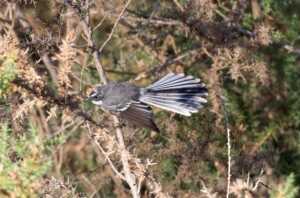
Grey Fantail utilising prickly cover of Gorse, (an invasive weed), with its tail characteristically fanned. Photo by Damian Kelly.
Bird of the Month is a partnership between Connecting Country and BirdLife Castlemaine District. Each month we take a close look at one special local bird species. We are blessed to have the brilliant Jane Rusden and Damian Kelly from BirdLife Castlemaine District writing these! We’re excited to join forces to deliver you a different bird each month, seasonally adjusted, and welcome suggestions from the community.
Great Southern Bioblitz – Castlemaine Region 24-27 October
Posted on 16 October, 2025 by Lori
It’s the beginning of October and so wonderful to see the new growth and increasing activity in bushlands and gardens after so many months of challenging conditions. Trees, shrubs and other understorey plants are putting out new leaves and foliage, and canopies are becoming denser. Birds are calling and nesting. Frogs are croaking. Thankfully insects are about again, albeit not in good numbers yet, but Painted Ladies and some day moths are about. And we are already being treated with the bright colours of Myrnong, Waxlips, Leopard orchids and Caladenias, with scattered clusters of emerging leaves promising Helmet and Gnat orchids.
Hopefully while all of this is happening those of you who live in or visit the Mount Alexander Shire will be getting ready for the Great Southern Bioblitz 2025,which runs from midnight October 23 to midnight October 27. This is your opportunity to join other citizen scientists to help build the scientific databases that increase the knowledge and understanding of our bushlands and their biodiversity. These annual Bioblitz surveys collect vast amounts of data on species and distribution that would otherwise be unavailable.
The Castlemaine Field Naturalists Club are again hosting a count in this region and they’d love your contributions! If you can contribute, all you need is a camera or phone and enthusiasm!
You’ll find lots of information, including deadlines, tips on uploading your images to iNaturalist, the online global databank for observations of biodiversity and more on the Castlemaine Field Naturalists Club Great Southern Bioblitz webpage.
Images: Castlemaine Field Naturalists Club
North Harcourt Sedgwick Landcare Group AGM with Ira Barker
Posted on 16 October, 2025 by Lori
North Harcourt Sedgwick Landcare (NHSE) are pleased to welcome Ira Barker from bushfoods social enterprise, Murnong Mummas, as the special guest speaker at the Groups Annual General Meeting.
A Gunditjmara person living and working on Djaara Country, Ira will share their journey connecting with native edible plants, culture, and Country, and how a drive for self determination has had a positive effect on them and those around them.
AGM business will include the annual activity report, and the election of the committee for the next year. They welcome new nominations to the committee – contact nhselandcare@gmail.com for more information.
A free BBQ will follow the formal business.
When: Sunday 26 October 11am-12pm
Where: Sedgwick Hall, Sedgwick
Bookings: Free (gold coin donation will be appreciated) – click here to book.
Taradale Landcare AGM and nestbox installation demonstration
Posted on 8 October, 2025 by Lori
Taradale Landcare are hosting their Annual General Meeting on Sunday 12 October in Taradale, VIC and encourage new members and committee nominations. Following the usual AGM formalities and refreshments, Tom from The Tree Company will provide a nestbox presentation and installation demonstration at Taradale Mineral Springs Reserve.
When: Sunday 12 October, 10am – 11.30am
Time: AGM 10am – 11.30am – Taradale Primary School multi-purpose room
Nestbox installation 12noon – Taradale Mineral Springs Reserve
RSVP: taradalelandcare@gmail.com
Baynton Sidonia Landcare present Taungurung Cultural Heritage Workshop: Fri 17 October 2025
Posted on 6 October, 2025 by Hadley Cole
Our friends at Baynton Sidonia Landcare are hosting a Strengthening Landholder Knowledge of Taungurung Cultural Heritage Workshop on Friday 17 October from 10.30am to 1.30pm at the Baynton Hall.
The aim of the workshop is to build landholder knowledge and confidence to support the preservation of Taungurung Culture on Country and to create shared pride in it.
The workshop will include:
- Understanding cultural heritage on your land
- Identifying cultural sites and artefacts
- What to do if you find artefacts on your property
- Working together for culturally sensitive land management
Where: Baynton Hall, 51 Darlington Road, Baynton VIC
When: Friday 17 October, 10.30am – 1.30pm
Bookings essential: The workshop is free, but a gold coin donation is appreciated. All are welcome, but booking is essential by texting Clare on 0423294430 with full names of attendees, telephone numbers, dietary constraints and the district you live in. Bookings will be confirmed or you will be placed on a waiting list. Please do not attend unless you have a confirmed booking.
Seed Collection Workshop with Seeding Victoria
Posted on 2 October, 2025 by Hadley Cole
Seeding Victoria is a community not-for-profit working hard to provide provenance based seed supply for revegetation projects throughout Central, South West and North West Victoria. The work of Seeding Victoria is crucial to the implementation of successful restoration.
In partnership with Natural Resource Conservation Trust, Cassinia Environmental and Connecting Country, Seeding Vic. presents a Seed Collection Workshop on Saturday 18th October 2025 in Castlemaine.
This workshop offers local community members the opportunity to take direct action to increase flora populations across the region through the development of seed collection skills and local flora identification. Through the collection of seed and growing of indigenous plant species, particularly those that are rare, we can increase genetic diversity and population of local indigenous flora, creating resilient ecosystems and seed banks for our future.
The day will involve;
- The nuts and bolts to seed collecting: You will learn species identification, what permits you need to obtain for collecting seed, OH&S, collection techniques, extraction and storage.
- Field Trip: We will have a look at the OH&S components of seed collecting, observing what’s flowering and what will be ready to collect in the coming months.
- There will be an opportunity to order seed-collecting equipment on the day.
- Learn about how the Natural Resource Conservation Trust Seed Bank Revolving Fund works and how to obtain a discount for seed-collecting equipment.
- Introduction to the BushBank Program: How to get involved in collecting seed for the $30M Government program and access funding to undertake biodiversity planting on your property.
When: Saturday 18 October 2025, 9.30am – 3.30pm
Where: Castlemaine Botanical Gardens Tea Rooms, Downes Rd. Castlemaine
Cost: $30.
For more information and bookings – click here
This workshop is funded by Cassinia Environmental, Natural Resources Conservation Trust and the Victorian Government BushBank program.
Bird of the Month: Australian White Ibis
Posted on 24 September, 2025 by Lori
Written by Damian Kelly and Jane Rusden
You may have heard of the “Bin Chicken”? Otherwise known as the Australian White Ibis (Threskiornis moluccus), a much more sedate and maybe slightly boring name compared to the descriptive and very Aussie title of Bin Chicken! A larger white bodied bird with a black head, neck, bill, tail and legs, that is in fact quite handsome … except when it’s been foraging in a rubbish tip and looking very dirty and disheveled. Oh well, I guess they scrub up well after a rinse in the rain.
A widespread species, this Ibis is common across much of eastern and northern Australia, and more recently around Perth. It has proven to be a very adaptable species and as its natural breeding areas have been reduced, it has simply moved into the cities. Here it has adapted to local parks and waterways as well as rubbish dumps. In addition, it has learnt to exploit rubbish bins – hence the name sometimes used of “Bin chicken”.
In the Mount Alexander Shire, the White Ibis can be regularly found in the Botanic Gardens in Castlemaine where we spotted one recently, as well as along waterways foraging for terrestrial and aquatic invertebrates. As a nomadic bird it will move around reacting to floods, dry years and associated food availability. As recently as 1998 the Macquarie Marshes in NSW had up to 11,000 nests recorded. However, White Ibis no longer breed there due to a reduction in habitat and drought and have instead irrupted in many cities and towns around the country.
Unlike closely related species such as the Straw-necked Ibis and Spoonbills, which are not common near human habitation, the White Ibis have adapted to living in close proximity to humans as well as changing their diet to include refuse. This has allowed them to thrive in urban areas and interestingly, like the Corella discussed in a previous Bird of the Month article, human intervention was probably involved. The Taronga Park Zoo in Sydney established free flying flocks in the early 1970s. Similar flocks were established at the Healesville Sanctuary in Victoria, Tidbinbilla in the ACT and Currumbin Wildlife Sanctuary in Queensland. These birds were habituated to humans at these sites and often began breeding there, unlike wild populations that were breeding elsewhere. And the rest is history. Attempts to move them on from Healesville to Sale in Gippsland failed as the birds promptly returned to their old home.
Breeding usually occurs in spring, but can vary depending on water levels. Nests are a platform of sticks usually near water and often in company with other species such as herons, spoonbills and cormorants. Two to three eggs are laid.
Although some people are not impressed by their behaviour, the White Ibis is on the coat of arms of the City of Griffith (where wild populations are common) and Hunter’s Hill in Sydney which is more likely to have bin chickens. Some of the refuse foraging habits of the White Ibis are a bit grim, but the upside of this species being so comfortable in urban areas, is their foraging method of probing the ground looking for invertebrates, which in turn aerates and improves soil health in our parks, gardens and sports ovals. They are also known as a friend to farmers when large flocks turn up to feast on infestations of pest insects.
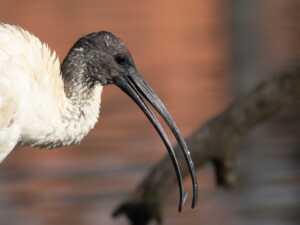
The black head feathers and bill of a White Ibis, including a feather on its bill tip from preening. Photo by Jane Rusden
Bird of the Month is a partnership between Connecting Country and BirdLife Castlemaine District. Each month we take a close look at one special local bird species. We are blessed to have the brilliant Jane Rusden and Damian Kelly from BirdLife Castlemaine District writing these! We’re excited to join forces to deliver you a different bird each month, seasonally adjusted, and welcome suggestions from the community.
Community Fire Forum – Inglewood
Posted on 10 September, 2025 by Lori
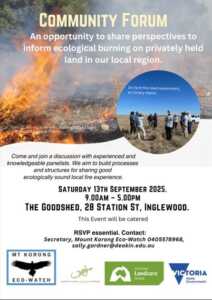 Just up the road in Inglewood, the Mt Korong Eco-Watch (MKEW) are being supported by Loddon Plains Landcare Network to host a Community Fire Forum this Saturday 13 September 2025. It is sure to be a great opportunity to contribute to this rarely discussed topic with many knowledgeable and experienced panelists.
Just up the road in Inglewood, the Mt Korong Eco-Watch (MKEW) are being supported by Loddon Plains Landcare Network to host a Community Fire Forum this Saturday 13 September 2025. It is sure to be a great opportunity to contribute to this rarely discussed topic with many knowledgeable and experienced panelists.
Mt Korong Eco-Watch (MKEW) have been conducting a series of conversations among private landholders and others over a 10-month period about ecological practices of fire. This forum will bring these conversations to a focus and with a wider group of participants. The aim is to explore the potential for establishing a sustainable process for sharing fire experiences with each other, learning together and offering guidance to others.
Contributors to the forum include Paul Foreman (Blue Devil Consulting/Biolinks Alliance), Terri Williams (landholder and teacher Bendigo TAFE), Oli Moraes (DJAARA), Peter Morison (formerly Trust for Nature), Karen Tymms (Trust for Nature), Dale Tonkinson (Biodiversity Officer CFA) and others.
When: Saturday 13 September 9am-5pm
Where: The Goodshed, 28 Station Street, Inglewood
Bookings: Essential. Contact Mount Korong Eco-Watch Secretary, Sally Gardner. Phone 0405 578 968 or email sally.gardner@deakin.edu.au
Spring into BushBank: Cassinia Environmental showcases restoration projects across Victoria
Posted on 10 September, 2025 by Lori
All over Victoria, nature restoration projects are underway on private land as part of the State Government’s BushBank Program.
The Victorian Government’s $77 million BushBank program provides a unique opportunity for private landowners to play a meaningful role in addressing climate change and supporting wildlife, leaving a legacy for generations to come. Delivered by Cassinia Environmental, the BushBank Private Land Stream supports private landowners to undertake restoration projects. Restored sites are permanently protected by Trust for Nature with conservation covenants.
BushBank is the most ambitious restoration program in Victoria’s history and its delivery will continue until 2035. Expressions of interest are open to landowners with a minimum 20 hectares available for restoration.
To learn more about the program, key delivery partner, Cassinia Environmental, is inviting community members, conservationists and landowners to find out more by taking part in its spring BushBank events. Designed to showcase restoration success stories and inform curious landowners, these events offer the opportunity to see unique revegetation models in action.
Across 53 projects, the BushBank Private Land Stream has secured 8,699 hectares towards the ambitious 20,000 hectare goal. To date, 4,800 hectares have already been restored. The program is creating long-term conservation outcomes and offers new opportunities for landowners through revegetation, covenants and access to carbon markets.
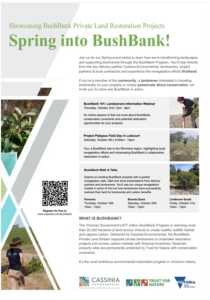 Spring BushBank events include:
Spring BushBank events include:
BushBank 101: Landowners Discovery Webinar
Thursday, October 2nd, 7pm – 8pm
An online session hosted by Cassinia Environmental to introduce BushBank, conservation covenants and potential restoration opportunities, ideal for landowners curious about what the program involves and how to get started.
Project Platypus Field Day in Ledcourt
Saturday, October 4th, 10am – 12pm
Hosted by Project Platypus, this event offers a BushBank site tour and discussion of local revegetation efforts in the Wimmera region, showcasing BushBank’s collaborative restoration in action.
Walk & Talk: BushBank Restoration in Action
These on-site events provide a unique opportunity to visit a BushBank site and participate in a guided revegetation walk, Q&A and short presentations from delivery partners and landowners. Each property offers a unique landscape, backstory and revegetation process, giving attendees a firsthand look at successful restoration creating biodiversity and carbon benefits.
Walk & Talk Peronne
Thursday October 16th, 10am – 12pm
Explore this unique conservation site where large-scale restoration is underway with support from Land Life and Greening Australia. Attendees will see revegetation tailored to support the Red-tailed Black Cockatoo and other native fauna, and hear from contractors and seed collectors about the site’s transformation.
Walk & Talk Bonnie Doon
Saturday October 25th, 10am – 12pm
Meet landowner Lachlan Cook, whose 37 hectare property is a model for carbon and biodiversity restoration. Hear about his experience registering a carbon project and walk through steep, formerly grazed hills now regenerating with native species like Yellow Box and White Box. Plantings have been tailored across three ecological vegetation classes with a mix of direct seeding and seedlings.
Walk & Talk Lindenow South
Friday October 31st, 10am – 12pm
Tour a self-managed BushBank site restored by a bold landowner who has overcome challenging soil conditions and degraded pasture to establish thriving revegetation. Visitors will explore interesting direct seeding and planting techniques and hear practical insights into soil management, local flora and long term site care.
To learn more or to participate in the free “Spring into BushBank” events, visit www.cassinia.com/bushbank.
Taking Root and Branching Out
Posted on 3 September, 2025 by Lori
To celebrate Landcare Week in August, Connecting Country teamed up with Barkers Creek Landcare and Wildlife Group (BCLWG) to host a special event titled Taking Root and Branching Out on Wednesday 6 August at Phee Broadway, Castlemaine. The event centred on the launch of a beautiful audio documentary developed by local, award-winning podcast creator (and member of BCLWG), Kyla Brettle. It tells the story about the long tail of environmental damage wrought by the colonial gold rush in Central Victoria and the almost 30 year history of a tiny community group (Barkers Creek Landcare and Wildlife Group) striving to make a difference alongside a broader account of social change and the value of land-caring.
Over 150 people came to hear and learn in what has been described by some attendees as a more unusual, but extremely engaging and centering, experience where the focus was to ‘listen in’ without the overstimulation of heavy visuals. The podcast artfully articulates the journey of both landscape transformation and community learnings alongside music and local voices and you can’t help but be captivated.
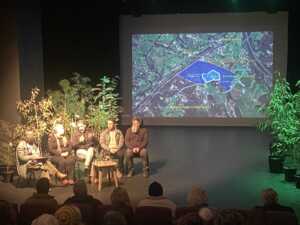
Photo: Sharon Fraser and members of the panel (L-R) Cath Jolly, Paul Foreman, Oli Moraes and Brendan Sydes discussing the Reserve.
After the podcast BCLWG provided a delicious sticky supper, a taste of the style of morning teas many Landcare groups strive after the heavy lifting of on-ground working bees. Sharon Fraser, MC for the evening then led a discussion panel about future plans for the Barkers Creek Reserve in Harcourt. Panel members Cath Jolly (BCLWG Secretary), Paul Foreman, ecologist with Biolinks Alliance, Oli Moraes, Galk-galk Dhelkunya Project Manager with DJAARA and Connecting Country President, Brendan Sydes emphasised the importance of engaging with partners and ‘experts’ to make a significant impact to our damaged countryside and the ongoing need for significant funding to achieve this ambition.
It was a heart-warming event and a big thanks go out to the Barkers Creek crew for creating this special evening in the center of Landcare Week as a celebration of what Landcare can achieve, but also what we can aspire to. If you missed it, a link to the podcast is available here and Kyla has written a reflection on the event on her Endgame Substack page.
This special event was hosted by Barkers Creek Landcare and Wildlife Group and Connecting Country with funding and support from The Victorian Landcare Program, North Central Catchment Management Authority, Ian and Shirley Norman Foundation, Mount Alexander Shire Council, The Little Red Apple, Biolinks Alliance and The Good Opp Shop.
Friends of Box Ironbark Forest AGM with ‘Living with Wildlife’ presentation by Tanya Loos
Posted on 3 September, 2025 by Lori
Do you have you have a bird attacking a window, a possum in the roof, phascogales harassing your chickens, or a visiting venomous snake in the backyard? Or just want to learn more about local wildlife and how to live with them. Get along to the Friends of Box Ironbark Forests AGM and hear from popular and entertaining local presenter, Tanya Loos.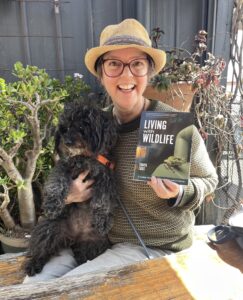
Tanya lives in central Victoria and is passionate about wildlife and nature! She has worked as a Woodland Bird Project Coordinator for Connecting Country and Biodiversity Projects Officer for Macedon Ranges City Council – and at present she is Avian Influenza Response Coordinator at BirdLife Australia.
Tanya loves sharing nature knowledge about how to live more harmoniously with the animals that live where we live – and how our homes and backyards can be safe havens in a time of climate breakdown. Tanya believes there are simple steps we can take that are wildlife friendly and make sure your place is a haven. In her presentations, Tanya loves drawing from ecological science to educate and inspire people to care about wildlife and wildlife habitat.
Tanya will be sharing her passion through an entertaining presentation at the Friends of the Box-Ironbark Forests AGM at 6pm on Monday 8th September at the Castlemaine Senior Citizens Centre, Mechanics Lane, Castlemaine. This will be followed by a light supper and the opportunity to buy Tanya’s book ‘Living with wildlife’, FOBIFs excellent field guides and a raffle ticket for gorgeous lithographs of the anticlinal fold, hakea or banksia by local artist Bev Lewis.
Where: Castlemaine Senior Citizens Centre, Mechanics Lane, Castlemaine.
More information: visit the FOBIF website.
National Tree Day 2025 (take 2) on Campbells Creek
Posted on 25 August, 2025 by Lori
A wonderful morning was spent on djaara country with over 110 volunteers celebrating (a postponed) National Tree Day on Sunday 24 August along the Campbells Creek.
After having to postpone the event from its scheduled date (the last Sunday in July) due to the very wet conditions, the weather gods shone brightly on us and it was all perfect blue, sunny skies. Kangaroos grazed in nearby paddocks and the heady smell of early flowering wattles hung in the air as the great swarm of people planted over 3000 plants along both sides of the newly completed shared trail upstream of Princess Street, Campbells Creek.
The site was well prepared and soft for planting following ripping by Council earlier in the season. The plant list included a great array of largely ground storey plants – Poas, Lomandras, Carex and Stipas – including some threatened species of Dianella and Lomandra. Silver Banksias, Meleleucas and Bursarias were also in the mix to help build that critical middle-storey habitat so often missing in our local landscape.
A big shout out to Sophie from the Community Bank Maldon and District and Helen from the Victorian National Parks Association for keeping kids busy making nature-themed badges and mini-forests whilst parents planted nearby. A good BBQ feed provided by Castlemaine Rotary helped refuel the energy needed to help finish planting into the early afternoon.
Thanks to all that came along and helped out and a big thank-you to our event partners Friends of Campbells Creek Landcare Group who did a great job on coordinating the planting and Grace from Nalderun Education Aboriginal Corporation for showcasing some of the local bushfoods being grown at MeMandook Gulk.
This event would not have been possible without the wonderful support from local event sponsors The Hub Foundation, Community Bank Maldon & District, Mount Alexander Shire Council.
Bird of the month: The Corvids – Ravens and Crows
Posted on 18 August, 2025 by Lori
Article by Damian Kelly and Jane Rusden
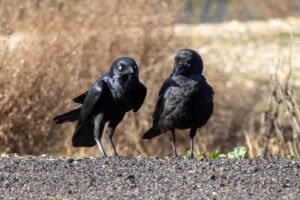
Little Ravens (most likely) at Coliban Waters Castlemaine Water Treatment Plant Bird Hide. (Photo Jane Rusden)
At the brand new bird hide put in by Coliban Water at the treatment plant in Castlemaine *, waterbirds and waders are the obvious focus when bird watching. However, a pair of what I believe are Little Ravens were caught goofing around in a very silly display, quite unlike the often cooler demeanor we usually see in this species. The sighting led us down the Corvid “rabbit hole”. Reading on, you’ll discover why I have not definitively stated which of our two local species the photos are of.
Although ravens are not always popular with people for various reasons, it is important to acknowledge that they perform an important scavenger role in cleaning up dead wildlife as well as eating a variety of agricultural insect pests as well as seeds. They are omnivorous and feed mostly on the ground. Ravens have adapted to a wide variety of habitats and are common around farms as well as cities, and obviously Water Treatment Plants.
Australia has five species – Australian Raven, Little Raven, Forest Raven, Torresian Crow and Little Crow. To quote the Handbook of Australian and New Zealand Birds (HANZAB): “All Australian Corvus are very difficult to distinguish and great care is needed to identify species.” Even the experts can be confused!
Whilst on the face of it all species look similar, in reality it is fairly easy to identify a species based on location – in most areas only one or two species are present. Around the Mount Alexander region we only have two species – Australian Raven and Little Raven and the Little Raven is far more common. Travelling further afield of course can be tricky. And unless you want a bird identification head ache, you don’t want to be in the north coast of NSW where all five can be found.
Locally the Little Raven is the most common and can be seen in large groups out of breeding season. Calls of our two local species are quite different with the Australian Raven tending to be longer and more drawn out than the Little Raven. You are best to listen to the calls on a birding app on your phone to become familiar with each, as trying to describe sounds in words is often not a lot of use.
Working out the age of a bird can be done by checking out the iris of the eye: adults are white with a bluish ring around the pupil, immatures are brown and juveniles blue-grey. Other indicators sometimes used to aid identification such as the throat hackles or colour at the base of feathers are often not much use in the field.
Pairs of Australian Ravens are generally sedentary and defend their territories all year round whereas Little Ravens move a lot, only defending small territories during breeding season and then joining large mobile flocks after breeding. These movements have been recorded over distance of several hundred kilometres at times, specially with juvenile and immature birds.
Nests are usually an untidy collection of sticks with a softer internal lining high up in large trees. Both parents build the nest and feed the young, but only the female does the incubation. Currently there is a pair either renovating or building a nest high up in the Big Tree in Guildford.
In many Aboriginal language groups, the raven is seen as a trickster or hero. Ravens have been recorded using tools such as sticks to retrieve food such as larvae from logs or dropping items on hard surfaces to crack them open. They also store food in caches for later use and can remember the location for long periods. Hikers’ packs are also fair game as ravens have learned to open small pockets and even sealed bags. Some field zoologists have had to stop nest monitoring surveys of threatened bird species (or at least their route between nests) if an Australian Raven is in the area, as they learn to follow the researchers, find the nests and predate the chicks.
A pair of what we believe are Little Ravens, goofing about … perhaps strengthening their pair bond, at Coliban Waters Castlemaine Water Treatment Plant Bird Hide. (Photo by Jane Rusden)
* Note: to access the birdhide at the Coliban Water Treatment Plant, email communications@coliban.com.au to sign the access agreement form and apply for a key.
Bird of the Month is a partnership between Connecting Country and BirdLife Castlemaine District. Each month we take a close look at one special local bird species. We are blessed to have the brilliant Jane Rusden and Damian Kelly from BirdLife Castlemaine District writing these! We’re excited to join forces to deliver you a different bird each month, seasonally adjusted, and welcome suggestions from the community.
